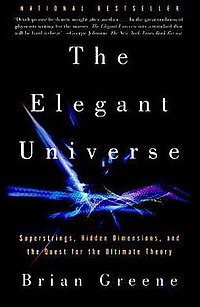BRIAN GREENE
The Elegant Universe
Superstrings, Hidden Dimensions, and the Quest for the Ultimate Theory
The Universe at Its Smallest: What We Know about Matter
The ancient Greeks surmised that the stuff of the universe was made up of tiny "uncuttable" ingredients that they called atoms. Just as the enormous number of words in an alphabetic language is built up from the wealth of combinations of a small number of letters, they guessed that the vast range of material objects might also result from combinations of a small number of distinct, elementary building blocks. It was a prescient guess. More than 2,000 years later we still believe it to be true, although the identity of the most fundamental units has gone through numerous revisions.
In the nineteenth century scientists showed that many familiar substances such as oxygen and carbon had a smallest recognizable constituent; following in the tradition laid down by the Greeks, they called them atoms. The name stuck, but history has shown it to be a misnomer, since atoms surely are "cuttable." By the early 1930s the collective works of J. J. Thomson, Ernest Rutherford, Niels Bohr, and James Chadwick had established the solar systemÐlike atomic model with which most of us are familiar. Far from being the most elementary material constituent, atoms consist of a nucleus, containing protons and neutrons, that is surrounded by a swarm of orbiting electrons.
For a while many physicists thought that protons, neutrons, and electrons were the Greeks' "atoms." But in 1968 experimenters at the Stanford Linear Accelerator Center, making use of the increased capacity of technology to probe the microscopic depths of matter, found that protons and neutrons are not fundamental, either. Instead they showed that each consists of three smaller particles, called quarks — a whimsical name taken from a passage in James Joyce's Finnegan's Wakeup and down. A proton consists of two up-quarks and a down-quark; a neutron consists of two down-quarks and an up-quark. by the theoretical physicist Murray Gell-Mann, who previously had surmised their existence. The experimenters confirmed that quarks themselves come in two varieties, which were named, a bit less creatively,
Everything you see in the terrestrial world and the heavens above appears to be made from combinations of electrons, up-quarks, and down-quarks. No experimental evidence indicates that any of these three particles is built up from something smaller. But a great deal of evidence indicates that the universe itself has additional particulate ingredients. In the mid-1950s, Frederick Reines and Clyde Cowan found conclusive experimental evidence for a fourth kind of fundamental particle called a neutrino — a particle whose existence was predicted in the early 1930s by Wolfgang Pauli. Neutrinos proved very difficult to find because they are ghostly particles that only rarely interact with other matter: an average-energy neutrino can easily pass right through many trillion miles of lead without the slightest effect on its motion.
This should give you significant relief, because right now as you read this, billions of neutrinos ejected into space by the sun are passing through your body and the earth as well, as part of their lonely journey through the cosmos. In the late 1930s, another particle called a muon — identical to an electron except that a muon is about 200 times heavier — was discovered by physicists studying cosmic rays (showers of particles that bombard earth from outer space). Because there was nothing in the cosmic order, no unsolved puzzle, no tailor-made niche, that necessitated the muon's existence, the Nobel PrizeÐwinning particle physicist Isidor Isaac Rabi greeted the discovery of the muon with a less than enthusiastic "Who ordered that?" Nevertheless, there it was. And more was to follow.
Using ever more powerful technology, physicists have continued to slam bits of matter together with ever increasing energy, momentarily recreating conditions unseen since the big bang.
In the debris they have searched for new fundamental ingredients to add to the growing list of particles. Here is what they have found: four more quarks — charm, strange, bottom, and top — and another even heavier cousin of the electron, called a tau, as well as two other particles with properties similar to the neutrino (called the muon-neutrino and tau-neutrino to distinguish them from the original neutrino, now called the electron-neutrino). These particles are produced through high-energy collisions and exist only ephemerally; they are not constituents of anything we typically encounter.
But even this is not quite the end of the story. Each of these particles has an antiparticle partner — a particle of identical mass but opposite in certain other respects such as its electric charge (as well as its charges with respect to other forces discussed below). For instance, the antiparticle of an electron is called a positron — it has exactly the same mass as an electron, but its electric charge is +1 whereas the electric charge of the electron is -1. When in contact, matter and antimatter can annihilate one another to produce pure energy — that's why there is extremely little naturally occurring antimatter in the world around us.
Physicists have recognized a pattern among these particles, displayed in Table 1.1. The matter particles neatly fall into three groups, which are often called families. Each family contains two of the quarks, an electron or one of its cousins, and one of the neutrino species. The corresponding particle types across the three families have identical properties except for their mass, which grows larger in each successive family. The upshot is that physicists have now probed the structure of matter to scales of about a billionth of a billionth of a meter and shown that everything encountered to date — whether it occurs naturally or is produced artificially with giant atom-smashers — consists of some combination of particles from these three families and their antimatter partners.
A glance at Table 1.1 will no doubt leave you with an even stronger sense of Rabi's bewilderment at the discovery of the muon. The arrangement into families at least gives some semblance of order, but innumerable "whys" leap to the fore. Why are there so many fundamental particles, especially when it seems that the great majority of things in the world around us need only electrons, up-quarks, and down-quarks? Why are there three families? Why not one family or four families or any other number? Why do the particles have a seemingly random spread of masses — why, for instance, does the tau weigh about 3,520 times as much as an electron? Why does the top quark weigh about 40,200 times as much an up-quark? These are such strange, seemingly random numbers. Did they occur by chance, by some divine choice, or is there a comprehensible scientific explanation for these fundamental features of our universe?
The Forces, or, Where's the Photon?
Things only become more complicated when we consider the forces of nature. The world around us is replete with means of exerting influence: balls can be hit with bats, bungee enthusiasts can throw themselves earthward from high platforms, magnets can keep superfast trains suspended just above metallic tracks, Geiger counters can tick in response to radioactive material, nuclear bombs can explode. We can influence objects by vigorously pushing, pulling, or shaking them; by hurling or firing other objects into them; by stretching, twisting, or crushing them; or by freezing, heating, or burning them. During the past hundred years physicists have accumulated mounting evidence that all of these interactions between various objects and materials, as well as any of the millions upon millions of others encountered daily, can be reduced to combinations of four fundamental forces. One of these is the gravitational force. The other three are the electromagnetic force, the weak force, and the strong force.
Gravity is the most familiar of the forces, being responsible for keeping us in orbit around the sun as well as for keeping our feet firmly planted on earth. The mass of an object measures how much gravitational force it can exert as well as feel. The electromagnetic force is the next most familiar of the four. It is the force driving all of the conveniences of modern life — lights, computers, TVs, telephones — and underlies the awesome might of lightning storms and the gentle touch of a human hand. Microscopically, the electric charge of a particle plays the same role for the electromagnetic force as mass does for gravity: it determines how strongly the particle can exert as well as respond electromagnetically.
The strong and the weak forces are less familiar because their strength rapidly diminishes over all but subatomic distance scales; they are the nuclear forces. This is why these two forces were discovered only much more recently. The strong force is responsible for keeping quarks "glued" together inside of protons and neutrons and keeping protons and neutrons tightly crammed together inside atomic nuclei. The weak force is best known as the force responsible for the radioactive decay of substances such as uranium and cobalt.
During the past century, physicists have found two features common to all these forces. First, as we will discuss in Chapter 5, at a microscopic level all the forces have an associated particle that you can think of as being the smallest packet or bundle of the force. If you fire a laser beam — an "electromagnetic ray gun" — you are firing a stream of photons, the smallest bundles of the electromagnetic force. Similarly, the smallest constituents of weak and strong force fields are particles called weak gauge bosons and gluons. (The name gluon is particularly descriptive: You can think of gluons as the microscopic ingredient in the strong glue holding atomic nuclei together.) By 1984 experimenters had definitively established the existence and the detailed properties of these three kinds of force particles, recorded in Table 1.2. Physicists believe that the gravitational force also has an associated particle — the graviton — but its existence has yet to be confirmed experimentally.
The second common feature of the forces is that just as mass determines how gravity affects a particle, and electric charge determines how the electromagnetic force affects it, particles are endowed with certain amounts of "strong charge" and "weak charge" that determine how they are affected by the strong and weak forces. (These properties are detailed in the table in the endnotes to this chapter.1) But as with particle masses, beyond the fact that experimental physicists have carefully measured these properties, no one has any explanation of why our universe is composed of these particular particles, with these particular masses and force charges.
Notwithstanding their common features, an examination of the fundamental forces themselves serves only to compound the questions. Why, for instance, are there four fundamental forces? Why not five or three or perhaps only one? Why do the forces have such different properties? Why are the strong and weak forces confined to operate on microscopic scales while gravity and the electromagnetic force have an unlimited range of influence? And why is there such an enormous spread in the intrinsic strength of these forces?
To appreciate this last question, imagine holding an electron in your left hand and another electron in your right hand and bringing these two identical electrically charged particles close together. Their mutual gravitational attraction will favor their getting closer while their electromagnetic repulsion will try to drive them apart. Which is stronger? There is no contest: The electromagnetic repulsion is about a million billion billion billion billion (10 to the 42th) times stronger! If your right bicep represents the strength of the gravitational force, then your left bicep would have to extend beyond the edge of the known universe to represent the strength of the electromagnetic force.
The only reason the electromagnetic force does not completely overwhelm gravity in the world around us is that most things are composed of an equal amount of positive and negative electric charges whose forces cancel each other out. On the other hand, since gravity is always attractive, there are no analogous cancellations — more stuff means greater gravitational force. But fundamentally speaking, gravity is an extremely feeble force. (This fact accounts for the difficulty in experimentally confirming the existence of the graviton. Searching for the smallest bundle of the feeblest force is quite a challenge.) Experiments also have shown that the strong force is about one hundred times as strong as the electromagnetic force and about one hundred thousand times as strong as the weak force. But where is the rationale — the raison d'etre — for our universe having these features?
This is not a question borne of idle philosophizing about why certain details happen to be one way instead of another; the universe would be a vastly different place if the properties of the matter and force particles were even moderately changed. For example, the existence of the stable nuclei forming the hundred or so elements of the periodic table hinges delicately on the ratio between the strengths of the strong and electromagnetic forces. The protons crammed together in atomic nuclei all repel one another electromagnetically; the strong force acting among their constituent quarks, thankfully, overcomes this repulsion and tethers the protons tightly together. But a rather small change in the relative strengths of these two forces would easily disrupt the balance between them, and would cause most atomic nuclei to disintegrate. Furthermore, were the mass of the electron a few times greater than it is, electrons and protons would tend to combine to form neutrons, gobbling up the nuclei of hydrogen (the simplest element in the cosmos, with a nucleus containing a single proton) and, again, disrupting the production of more complex elements.
Stars rely upon fusion between stable nuclei and would not form with such alterations to fundamental physics. The strength of the gravitational force also plays a formative role. The crushing density of matter in a star's central core powers its nuclear furnace and underlies the resulting blaze of starlight. If the strength of the gravitational force were increased, the stellar clump would bind more strongly, causing a significant increase in the rate of nuclear reactions. But just as a brilliant flare exhausts its fuel much faster than a slow-burning candle, an increase in the nuclear reaction rate would cause stars like the sun to burn out far more quickly, having a devastating effect on the formation of life as we know it. On the other hand, were the strength of the gravitational force significantly decreased, matter would not clump together at all, thereby preventing the formation of stars and galaxies.
We could go on, but the idea is clear: the universe is the way it is because the matter and the force particles have the properties they do. But is there a scientific explanation for why they have these properties?
String theory offers a powerful conceptual paradigm in which, for the first time, a framework for answering these questions has emerged. Let's first get the basic idea.
The particles in Table 1.1 are the "letters" of all matter. Just like their linguistic counterparts, they appear to have no further internal substructure. String theory proclaims otherwise. According to string theory, if we could examine these particles with even greater precision — a precision many orders of magnitude beyond our present technological capacity — we would find that each is not pointlike, but instead consists of a tiny one-dimensional loop. Like an infinitely thin rubber band, each particle contains a vibrating, oscillating, dancing filament that physicists, lacking Gell-Mann's literary flair, have named a string. In Figure 1.1 we illustrate this essential idea of string theory by starting with an ordinary piece of matter, an apple, and repeatedly magnifying its structure to reveal its ingredients on ever smaller scales. String theory adds the new microscopic layer of a vibrating loop to the previously known progression from atoms through protons, neutrons, electrons and quarks.2
Although it is by no means obvious, we will see in Chapter 6 that this simple replacement of point-particle material constituents with strings resolves the incompatibility between quantum mechanics and general relativity. String theory thereby unravels the central Gordian knot of contemporary theoretical physics. This is a tremendous achievement, but it is only part of the reason string theory has generated such excitement.
 ,
, ,
, .
.




















